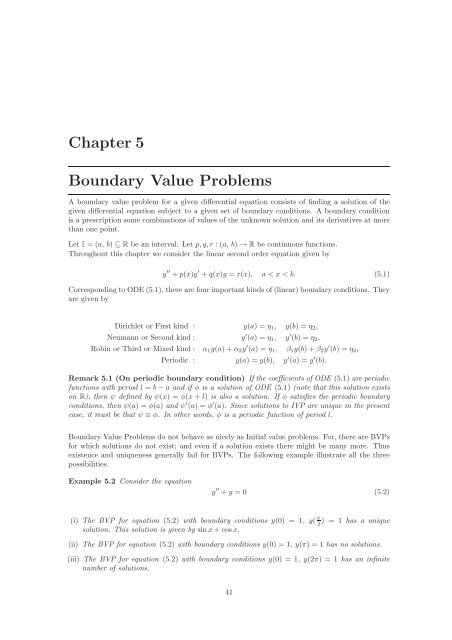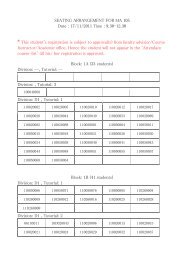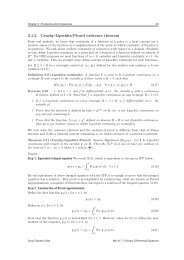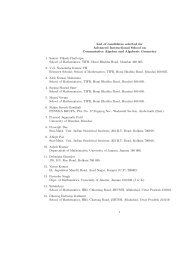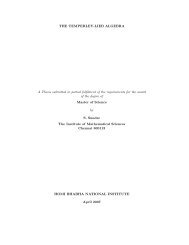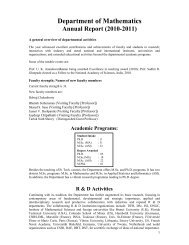Chapter 5 Boundary Value Problems
Chapter 5 Boundary Value Problems
Chapter 5 Boundary Value Problems
You also want an ePaper? Increase the reach of your titles
YUMPU automatically turns print PDFs into web optimized ePapers that Google loves.
<strong>Chapter</strong> 5<br />
<strong>Boundary</strong> <strong>Value</strong> <strong>Problems</strong><br />
A boundary value problem for a given differential equation consists of finding a solution of the<br />
given differential equation subject to a given set of boundary conditions. A boundary condition<br />
is a prescription some combinations of values of the unknown solution and its derivatives at more<br />
than one point.<br />
Let I = (a, b) ⊆ R be an interval. Let p, q, r : (a, b) → R be continuous functions.<br />
Throughout this chapter we consider the linear second order equation given by<br />
y ′′ + p(x)y ′ + q(x)y = r(x), a < x < b. (5.1)<br />
Corresponding to ODE (5.1), there are four important kinds of (linear) boundary conditions. They<br />
are given by<br />
Dirichlet or First kind : y(a) = η1, y(b) = η2,<br />
Neumann or Second kind : y ′ (a) = η1, y ′ (b) = η2,<br />
Robin or Third or Mixed kind : α1y(a) + α2y ′ (a) = η1, β1y(b) + β2y ′ (b) = η2,<br />
Periodic : y(a) = y(b), y ′ (a) = y ′ (b).<br />
Remark 5.1 (On periodic boundary condition) If the coefficients of ODE (5.1) are periodic<br />
functions with period l = b − a and if φ is a solution of ODE (5.1) (note that this solution exists<br />
on R), then ψ defined by ψ(x) = φ(x + l) is also a solution. If φ satisfies the periodic boundary<br />
conditions, then ψ(a) = φ(a) and ψ ′ (a) = φ ′ (a). Since solutions to IVP are unique in the present<br />
case, it must be that ψ ≡ φ. In other words, φ is a periodic function of period l.<br />
<strong>Boundary</strong> <strong>Value</strong> <strong>Problems</strong> do not behave as nicely as Initial value problems. For, there are BVPs<br />
for which solutions do not exist; and even if a solution exists there might be many more. Thus<br />
existence and uniqueness generally fail for BVPs. The following example illustrate all the three<br />
possibilities.<br />
Example 5.2 Consider the equation<br />
y ′′ + y = 0 (5.2)<br />
(i) The BVP for equation (5.2) with boundary conditions y(0) = 1, y( π<br />
2 ) = 1 has a unique<br />
solution. This solution is given by sinx + cosx.<br />
(ii) The BVP for equation (5.2) with boundary conditions y(0) = 1, y(π) = 1 has no solutions.<br />
(iii) The BVP for equation (5.2) with boundary conditions y(0) = 1, y(2π) = 1 has an infinite<br />
number of solutions.<br />
41
42 5.1. Adjoint forms, Lagrange identity<br />
5.1 Adjoint forms, Lagrange identity<br />
In mathematical physics there are many important boundary value problems corresponding to<br />
second order equations. In the studies of vibrations of a membrane, vibrations of a structure one<br />
has to solve a homogeneous boundary value problem for real frequencies (eigen values). As is wellknown<br />
in the case of symmetric matrices that there are only real eigen values and corresponding<br />
eigen vectors form a basis for the underlying vector space and thereby all symmetric matrices<br />
are diagonalisable. Self-adjoint problems can be thought of as corresponding ODE versions of<br />
symmetric matrices, and they play an important role in mathematical physics.<br />
Let us consider the equation<br />
Integrating zL[y] by parts from a to x, we have<br />
x<br />
a<br />
L[y] ≡ l(x)y ′′ + p(x)y ′ + q(x)y = 0, a < x < b. (5.3)<br />
zL[y] dx = (zl)y ′ − (zl) ′ y + (zp)y x<br />
a +<br />
If we define the second order operator L ∗ by<br />
x<br />
a<br />
(zl) ′′ − (zp) ′ + (zq) y dx. (5.4)<br />
L ∗ [z] ≡ (zl) ′′ − (zp) ′ + (zq) = l(x)z ′′ + (2l ′ − p)(x)z ′ + (l ′′ − p ′ + q)(x)z = 0, (5.5)<br />
then the equation (5.4) becomes<br />
x<br />
a<br />
∗ ′ ′ ′ x<br />
z L[y] − y L [z] dx = l(y z − yz ) + (p − l )y z . (5.6)<br />
a<br />
The operator L ∗ is called the adjoint operator corresponding to the operator L. It can be easily<br />
verified that adjoint of L ∗ is L itself. If L and L ∗ are the same, then L is said to be self-adjoint .<br />
Thus, the necessary and sufficient condition for L to be self-adjoint is that<br />
which is satisfied if<br />
Thus if L is self-adjoint, we have<br />
p = 2l ′ − p, andq = l ′′ − p ′ + q, (5.7)<br />
p = l ′ . (5.8)<br />
L[y] ≡ l(x)y ′′ + p(x)y ′ + q(x)y = l(x)y ′ ′ + q(x)y. (5.9)<br />
A general operator L may not be self-adjoint but it can always be converted into a self-adjoint by<br />
suitably multiplying L with a function.<br />
Lemma 5.3 (self-adjointisation) The operator h(x)L[y] is self-adjoint, where h is given by<br />
In fact h(x)L[y] is given by<br />
where<br />
h(x) = 1<br />
l(x) exp<br />
x<br />
p(t)<br />
l(t) dt<br />
<br />
. (5.10)<br />
<br />
d<br />
α(x)<br />
dx<br />
dy<br />
<br />
+ β(x)y = 0, (5.11)<br />
dx<br />
x<br />
p(t)<br />
α(x) = exp<br />
l(t) dt<br />
<br />
, β(x) = q(x)<br />
l(x) exp<br />
x<br />
p(t)<br />
l(t) dt<br />
<br />
. (5.12)<br />
MA 417: Ordinary Differential Equations Sivaji Ganesh Sista
<strong>Chapter</strong> 5 : <strong>Boundary</strong> <strong>Value</strong> <strong>Problems</strong> 43<br />
Exercise 5.4 (i) Prove that the self-adjoint form of the Legendre equation<br />
is<br />
(1 − x 2 )y ′′ − 2xy ′ + n(n + 1)y = 0 (5.13)<br />
d<br />
dx<br />
<br />
(1 − x 2 ) dy<br />
dx<br />
(ii) Prove that the self-adjoint form of the Bessel equation<br />
is<br />
<br />
+ n(n + 1)y = 0. (5.14)<br />
x 2 y ′′ + xy ′ + (x 2 − ν 2 )y = 0 (5.15)<br />
d<br />
dx<br />
Lagrange identity, Green’s identity<br />
<br />
x dy<br />
dx<br />
<br />
+<br />
<br />
x − ν2<br />
x<br />
Differentiating both sides of equation (5.6), we get Lagrange identity:<br />
<br />
y = 0. (5.16)<br />
∗ d ′ ′ ′<br />
z L[y] − y L [z] = l(y z − yz ) + (p − l )y z . (5.17)<br />
dx<br />
If we take x = b in the equation (5.6), we get Green’s identity:<br />
b<br />
a<br />
∗ ′ ′ ′ b<br />
z L[y] − y L [z] dx = l(y z − yz ) + (p − l )y z . (5.18)<br />
a<br />
If L is self-adjoint, then Green’s identity (5.18) reduces to<br />
b<br />
and Lagrange identity becomes<br />
a<br />
′ ′ b<br />
z L[y] − y L[z] dx = l(y z − yz ) , (5.19)<br />
a<br />
d ′ ′<br />
z L[y] − y L[z] = l(y z − yz ) . (5.20)<br />
dx<br />
5.2 Two-point boundary value problem<br />
In this section we are going to set up the notations that we are going to use through out our<br />
discussion of BVPs.<br />
We consider the linear nonhomogeneous second order in the self-adjoint form described below.<br />
Hypothesis (HBVP)<br />
Let f, q be continuous function on the interval [a, b]. Let p be a continuously differentiable<br />
and does not vanish on the interval [a, b]. Further assume that p > 0 on [a, b].<br />
The linear nonhomogeneous BVP in self-adjoint form then conists of solving the ODE<br />
L[y] ≡ d<br />
dx<br />
<br />
p(x) dy<br />
dx<br />
<br />
+ q(x)y = f(x), (5.21)<br />
along with two boundary conditions prescribed at a and b given by<br />
U1[y] ≡ a1y(a) + a2y ′ (a) = η1, U2[y] ≡ b1y(b) + b2y ′ (b) = η2, (5.22)<br />
where η1 and η2 are given constants; and the constants a1, a2, b1, b2 satisfy a2 1 + a2 2<br />
and b2 1 + b2 2 = 0.<br />
Sivaji Ganesh Sista MA 417: Ordinary Differential Equations<br />
= 0
44 5.2. Two-point boundary value problem<br />
Note that the boundary conditions are in the most general form, and they include the first three<br />
conditions given at the beginning of our discussion on BVPs as special cases.<br />
Let us introduce some nomenclature here.<br />
Definition 5.5 Assume hypothesis (HBVP). A nonhomogeneous boundary value problem consists of<br />
solving<br />
L[y] = f, U1[y] = η1, U2[y] = η2, (5.23)<br />
for given constants η1 and η2, and a given continuous function f on the interval [a, b].<br />
Definition 5.6 The associated homogeneous boundary value problem is then given by<br />
L[y] = 0, U1[y] = 0, U2[y] = 0. (5.24)<br />
Let us list some properties of the solutions for BVP that are consequences of the linearity of the<br />
differential operator L.<br />
Lemma 5.7 (i) A linear combination of solutions of the homogeneous BVP (5.24) is also a<br />
solution of the homogeneous BVP (5.24).<br />
(ii) If u, v are two solutions of the nonhomogeneous BVP (5.23), then their difference u − v is a<br />
solution of the homogeneous BVP (5.24).<br />
(iii) If y solves the nonhomogeneous BVP (5.23) and z solves the homogeneous BVP (5.24), then<br />
the function y + z nonhomogeneous BVP (5.23).<br />
(iv) Let u be a (fixed) solution of the nonhomogeneous BVP (5.23). Then any solution y of<br />
the nonhomogeneous BVP (5.23) is given by y = u + z for some function z that solves the<br />
homogeneous BVP (5.24).<br />
Given a fundamental pair of solutions to the ODE L[y] = 0, it is possible to say whether (and<br />
when) the homogeneous BVP has only trivial solution and is characterised in terms of the given<br />
fundamental pair. Recall that a fundamental pair of solutions to L[y] = 0 always exists.<br />
Lemma 5.8 Let φ1, φ2 be a fundamental pair of solutions to the ODE L[y] = 0. Then the<br />
following are equivalent.<br />
(1) The nonhomogeneous boundary value problem has a unique solution for any given<br />
constants η1 and η2, and a given continuous function f on the interval [a, b].<br />
(2) The associated homogeneous boundary value problem has only trivial solution.<br />
(3) The determinant<br />
<br />
<br />
<br />
U1[φ1]<br />
<br />
U1[φ2] <br />
<br />
U2[φ1] U2[φ2] = 0. (5.25)<br />
Before we give a proof of this result, let us make an observation concerning the condition (5.25).<br />
Remark 5.9 Though (3) above depends on a given fundamental pair, due to its equivalence with<br />
the (1) and (2), it is indeed the case that the condition (5.25) is independent of the choice of<br />
fundamental pair.<br />
Also note that there is a subtle difference between equivalence of (1) and (2), and the statement(s)<br />
of Lemma 5.7. What is it? In effect, equivalence of (1) and (2) does not really follow from<br />
Lemma 5.7. Therefore we will have to prove the equivalence of (1) and (2).<br />
MA 417: Ordinary Differential Equations Sivaji Ganesh Sista
<strong>Chapter</strong> 5 : <strong>Boundary</strong> <strong>Value</strong> <strong>Problems</strong> 45<br />
Proof :<br />
Our strategy for the proof is to prove (i). (1)⇐⇒(3) (ii). (2)⇐⇒(3). In fact, it is enough to<br />
prove (1)⇐⇒(3), since (2)⇐⇒(3) follows by taking f = 0, η1 = η2 = 0.<br />
We already illustrated how to find solutions of L[y] = f starting from a fundamental pair of solutions<br />
to the ODE L[y] = 0 and we gave an expression for a general solution of L[y] = f. Let us<br />
pick any one of such solutions, let us denote it by z.<br />
Since φ1, φ2 is a fundamental pair of solutions to the ODE L[y] = 0, general soution y of L[y] = f<br />
is given by<br />
y = z + c1φ1 + c2φ2, c1, c2 ∈ R. (5.26)<br />
Now y is a solution of nonhomogeneous BVP (5.23) if and only if we can solve for c1 and c2 from<br />
the algebraic equations<br />
U1[y] = U1[z] + c1U1[φ1] + c2U1[φ2] = η1, U2[y] = U2[z] + c1U2[φ1] + c2U2[φ2] = η2, (5.27)<br />
The above system (5.27) has a solution for every η1 and η2 if and only if (5.25) holds.<br />
Exercise 5.10 Consider the ODE<br />
y ′′ + y = f(x), 0 ≤ x ≤ π. (5.28)<br />
Determine if the following BVPs for the ODE (5.28) have unique solution for every f, η1, η2 by<br />
applying the above result.<br />
(i) U1[y] ≡ y(0) + y ′ (0) = η1, U2[y] ≡ y(π) = η2.<br />
(ii) U1[y] ≡ y(0) = η1, U2[y] ≡ y(π) = η2.<br />
Exercise 5.11 Prove that the nonhomogeneous BVP (posed on [0, π])<br />
y ′′ + y = 0, y(0) = 0, y(π) = 1 (5.29)<br />
has no solution. Comment on the solutions of the associated homogeneous BVP.<br />
5.3 Fundamental solutions, Green’s functions<br />
Fundamental solution of an ODE gives rise to a representation (integral) formula for solution of<br />
the nonhomogeneous equation. When we want to take care of boundary conditions, we impose<br />
boundary conditions on fundamental solutions and get Green’s functions. Thus Green’s functions<br />
give rise to a representation formula for solution of the nonhomogeneous BVP. The concepts of<br />
a fundamental solution as well as a Green’s function are defined in terms of the homogeneous<br />
BVPvassociated to the nonhomogeneous BVP.<br />
Let Q denote the square Q := [a, b] × [a, b] in the xξ-plane. Let us partition Q by the line x = ξ<br />
and call the two resulting triangles Q1 and Q2. Let<br />
Q1 = {(x, ξ) : a ≤ ξ ≤ x ≤ b },<br />
Q2 = {(x, ξ) : a ≤ x ≤ ξ ≤ b }.<br />
Note that the diagonal x = ξ belongs to both the triangles.<br />
Sivaji Ganesh Sista MA 417: Ordinary Differential Equations
46 5.3. Fundamental solutions, Green’s functions<br />
ξ<br />
Q2<br />
a ≤ x ≤ ξ ≤ b<br />
a ≤ ξ ≤ x ≤ b<br />
Q1<br />
Definition 5.12 (Fundamental solution) A function γ(x, ξ) defined in Q is called a fundamental<br />
solution of the homogeneous differential equation L[y] = 0 if it has the following properties:<br />
(i) The function γ(x, ξ) is continuous in Q.<br />
(ii) The first and second order partial derivatives w.r.t. variable x of the function γ(x, ξ) exist<br />
and continuous up to the boundary on Q1 and Q2.<br />
(iii) Let ξ ∈ [a, b] be fixed. Then γ(x, ξ), considered as a function of x, satisfies L[γ(., ξ)] = 0 at<br />
every point of the interval [a, b], except at ξ.<br />
(iv) The first derivate has a jump across the diagonal x = ξ, of magnitude 1/p, i.e.,<br />
<br />
∂γ<br />
∂x<br />
:= ∂γ ∂γ 1<br />
(ξ+, ξ) − (ξ−, ξ) = ,<br />
∂x ∂x p(ξ)<br />
a < ξ < b, (5.30)<br />
where ∂γ<br />
x=ξ<br />
∂γ<br />
∂x (ξ+, , ξ) is defined as the limit of ∂x (x, , ξ) as x → ξ+, i.e., (x, , ξ) ∈ Q1; and<br />
∂γ<br />
∂γ<br />
∂x (ξ−, , ξ) is defined as the limit of ∂x (x, , ξ) as x → ξ−, i.e., (x, , ξ) ∈ Q2. Note that plus<br />
and minus signs indicate that limits are taken from right and left sides of the diagonal x = ξ.<br />
A function is continuous up to the boundary of Qi means that function can be extended continuously<br />
to the boundary of Qi.<br />
Exercise 5.13 Prove that the condition (5.30) is equivalent to the condition<br />
<br />
∂γ<br />
∂x<br />
:= ∂γ ∂γ 1<br />
(x, x−) − (x, x+) = ,<br />
∂x ∂x p(x)<br />
a < x < b. (5.31)<br />
x=ξ<br />
Lemma 5.14 Assume hypothesis (HBVP). A fundamental solution exists but is not unique.<br />
Proof :<br />
For each a ≤ ξ ≤ b, let y(x; ξ) be the solution of the IVP<br />
Then<br />
L[y] = 0, y(ξ) = 0, y ′ (ξ) = 1<br />
. (5.32)<br />
p(ξ)<br />
γ(x, ξ) :=<br />
x<br />
<br />
0 for (x, ξ) ∈ Q2<br />
y(x; ξ) for (x, ξ) ∈ Q1<br />
is a fundamental solution, and can be verified easily.<br />
Let z be a solution of L[z] = 0, and let h ∈ C[a, b]. Then the function<br />
is also a fundamental solution.<br />
(5.33)<br />
γ1(x, ξ) := γ(x, ξ) + z(x)h(ξ) (5.34)<br />
MA 417: Ordinary Differential Equations Sivaji Ganesh Sista
<strong>Chapter</strong> 5 : <strong>Boundary</strong> <strong>Value</strong> <strong>Problems</strong> 47<br />
Example 5.15 With the definition a+ := max(0, a),<br />
(i) a fundamental solution for L[y] ≡ y ′′ = 0 is (x − ξ)+.<br />
(ii) a fundamental solution for L[y] ≡ y ′′ + λ2y = 0 is 1<br />
λ sin λ(x − ξ)+.<br />
Given a fundamental solution for the homogeneous equation L[y] = 0, one can easily construct a<br />
solution of nonhomogeneous equation L[y] = f, as asserted by the following result.<br />
Theorem 5.16 Assume hypothesis (HBVP). Let γ(x, ξ) be a fundamental solution. Then the<br />
function v defined by<br />
v(x) =<br />
b<br />
a<br />
γ(x, ξ)f(ξ)dξ (5.35)<br />
is twice continuously differentiable and is a solution of L[v] = f on the interval [a, b].<br />
Proof :<br />
We split the integral in (5.35) at the point x and write<br />
v(x) =<br />
x<br />
Differentiating (5.36) w.r.t. x yields<br />
v ′ x<br />
(x) = γ(x, x)f(x) +<br />
a<br />
a<br />
γ(x, ξ)f(ξ)dξ +<br />
b<br />
b<br />
∂γ<br />
(x, ξ)f(ξ)dξ − γ(x, x)f(x) +<br />
∂x x<br />
Since γ(x, ξ) is continuous, the above equation becomes<br />
v ′ (x) =<br />
x<br />
Differentiating (5.38) w.r.t. x yields<br />
v ′′ (x) = ∂γ<br />
x<br />
∂<br />
(x, x−)f(x) +<br />
∂x a<br />
2γ ∂x<br />
By Exercise 5.13, above equation (5.39) reduces to<br />
v ′′ (x) = 1<br />
x<br />
f(x) +<br />
p(x) a<br />
a<br />
x<br />
γ(x, ξ)f(ξ)dξ. (5.36)<br />
∂γ<br />
(x, ξ)f(ξ)dξ. (5.37)<br />
∂x<br />
b<br />
∂γ<br />
∂γ<br />
(x, ξ)f(ξ)dξ + (x, ξ)f(ξ)dξ. (5.38)<br />
∂x x ∂x<br />
b<br />
∂γ<br />
(x, ξ)f(ξ)dξ − (x, x+)f(x) +<br />
2 ∂x x<br />
∂2 b<br />
γ<br />
(x, ξ)f(ξ)dξ +<br />
∂x2 x<br />
∂2γ (x, ξ)f(ξ)dξ.(5.39)<br />
∂x2 ∂2γ (x, ξ)f(ξ)dξ. (5.40)<br />
∂x2 Since L[γ(., ξ)] = 0 (by definition of a fundamental solution), thanks to the above calculations,<br />
we get<br />
L[v] = pv ′′ + p ′ v ′ b<br />
+ qv =<br />
a<br />
L[γ(., ξ)](x, ξ)f(ξ)dξ + f(x) = f(x). (5.41)<br />
Definition 5.17 (Green’s function) A Green’s function G(x, ξ) for the homogeneous boundary<br />
value problem (5.24)<br />
L[y] = 0, U1[y] = 0, U2[y] = 0. (5.42)<br />
is defined by the following two properties:<br />
(i) G(x, ξ) is a fundamental solution of L[y] = 0.<br />
(ii) U1[G(., ξ)] = 0, U2[G(., ξ)] = 0 for each a < ξ < b.<br />
Sivaji Ganesh Sista MA 417: Ordinary Differential Equations
48 5.3. Fundamental solutions, Green’s functions<br />
5.3.1 Construction of Green’s functions<br />
In this paragraph we are going to construct Green’s functions under the assumption that the<br />
homogeneous BVP<br />
L[y] = 0, U1[y] = 0, U2[y] = 0. (5.43)<br />
has only trivial solution.<br />
Let (λ1, λ2) = (0, 0) be such that a1λ1 + a2λ2 = 0 and let φ1 be solution of L[y] = 0 satisfying<br />
φ1(a) = λ1 and φ ′ 1(a) = λ2. Choose another solution φ2 of L[y] = 0 similarly. This way of choosing<br />
φ1 and φ2 make sure that both are non-trivial solutions.<br />
Note that φ1 and φ2 form a fundamental pair of solutions of L[y] = 0, since we assumed that<br />
homogeneous BVP has only trivial solutions. <br />
′ p(φ 1φ2 − φ1φ ′ 2 ) = 0. This implies<br />
By Lagrange’s identity (5.20), we get d<br />
dx<br />
p(φ ′ 1φ2 − φ1φ ′ 2 ) ≡ c, a constant and non-zero, (5.44)<br />
as a consequence of (φ ′ 1φ2 − φ1φ ′ 2) being the wronskian corresponding to a fundamental pair of<br />
solutions.<br />
Green’s function is then given by<br />
G(x, ξ) := 1<br />
c<br />
<br />
φ1(x)φ2(ξ) for (x, ξ) ∈ Q2<br />
φ1(ξ)φ2(x) for (x, ξ) ∈ Q1.<br />
(5.45)<br />
Verifying that G(x, ξ) has the required properties for it to be a Green’s function is left as an<br />
exercise.<br />
Exercise 5.18 Verify that G(x, ξ) is indeed a Green’s function.<br />
Theorem 5.19 Assume hypothesis (HBVP). Assume that the homogeneous BVP (5.43) has only<br />
the trivial solution. Then<br />
(i) Green’s function for (5.43) exists and is unique.<br />
(ii) Green’s function is explicitly given by (5.45).<br />
(iii) Green’s function is symmetric, i.e.,<br />
G(x, ξ) = G(ξ, x). (5.46)<br />
(iv) The solution (which is unique by Lemma 5.8) of nonhomogeneous equation with homogogeneous<br />
boundary conditions, i.e.,<br />
is given by<br />
L[y] = f, U1[y] = 0, U2[y] = 0, (5.47)<br />
v(x) =<br />
b<br />
a<br />
G(x, ξ)f(ξ)dξ. (5.48)<br />
Proof :<br />
Proof of (iv) is already done in the context of fundamental solutions; and thus it remains to<br />
check the boundary conditions. Recall the computations we did in that proof of v ′ and v ′′ . Since<br />
G(x, ξ) satisfies boundary conditions, we have for i = 1, 2,<br />
<br />
b<br />
b<br />
Ui[v] = Ui G(x, ξ)f(ξ)dξ = Ui[G(., ξ)] f(ξ)dξ = 0. (5.49)<br />
a<br />
Existence of Green’s function follows from its construction, given before.<br />
MA 417: Ordinary Differential Equations Sivaji Ganesh Sista<br />
a
<strong>Chapter</strong> 5 : <strong>Boundary</strong> <strong>Value</strong> <strong>Problems</strong> 49<br />
Let us turn to the proof of uniqueness of Green’s function. If possible, let Γ be another Green’s<br />
function. Let<br />
v(x) =<br />
b<br />
a<br />
G(x, ξ)f(ξ)dξ, w(x) =<br />
b<br />
a<br />
Γ(x, ξ)g(ξ)dξ (5.50)<br />
with continuous functions f, g. Since Ui[v] = Ui[w] = 0, from Green’s identity for self-adjoint<br />
operators (5.19), and from (5.44), we get<br />
b<br />
a<br />
′ ′ b<br />
v L[w] − w L[v] dx = l(w v − wv ) = 0. (5.51)<br />
a<br />
Substituting the values of v and w in the above equation, and observing that L[v] = f and<br />
L[w] = g, we get<br />
b b<br />
a<br />
a<br />
g(x)G(x, ξ)f(ξ)dxdξ =<br />
By changing the order of integration, we get<br />
b b<br />
a<br />
b b<br />
Since the relation holds for arbitrary f and g, we must have<br />
a<br />
a<br />
a<br />
f(x)Γ(x, ξ)g(ξ)dxdξ (5.52)<br />
(G(x, ξ) − Γ(ξ, x)) f(ξ)g(x)dξ dx = 0. (5.53)<br />
G(x, ξ) = Γ(ξ, x). (5.54)<br />
Setting Γ = G, we get symmetry of Green’s function G; and now once again we get G = Γ and<br />
thus establishing uniqueness of Green’s function.<br />
Example 5.20 Green’s function for<br />
is given by<br />
y ′′ + y = 0 in [0, 1], y(0) = y(1) = 0 (5.55)<br />
G(x, ξ) :=<br />
<br />
ξ(x − 1) for 0 ≤ ξ ≤ x ≤ 1,<br />
x(ξ − 1) for 0 ≤ x ≤ ξ ≤ 1.<br />
Note that the homogeneous BVP in this case, has only trivial solution.<br />
(5.56)<br />
Exercise 5.21 How to solve general nonhomogeneous BVP? It is necessary to ask this question<br />
since Green’s functions give rise to solutions of nonhomogeneous equations but with homogeneous<br />
boundary conditions. (Hint: Use linearity of the differential operator) Solve, for instance, the<br />
non-homogeneous BVP<br />
y ′′ = f(x) in [0, 1], y(0) = 0, y(1) + y ′ (1) = 2. (5.57)<br />
Exercise 5.22 Solve the nonhomogeneous BVP<br />
y ′′ + y = e x in [0, 1], y(0) = y(1) = 0 (5.58)<br />
by (i) using a fundamental pair of solutions and a special solution of the nonhomogeneous differential<br />
equation; (ii) using Green’s function.<br />
Exercise 5.23 Find Green’s function for<br />
Exercise 5.24 Find Green’s function for<br />
(Hint: Try a change of variable x = e t )<br />
y ′′ = 0 in [0, 1], y ′ (0) = y(1) = 0 (5.59)<br />
y ′′ + 1<br />
= 0 in [1, 2], y(1) = y(2) = 0 (5.60)<br />
4x2 Sivaji Ganesh Sista MA 417: Ordinary Differential Equations
50 5.4. Generalised Green’s function<br />
5.4 Generalised Green’s function<br />
In Section 5.3 we constructed Green’s function for the homogeneous BVP when the latter problem<br />
had only trivial solutions. Now we investigate the case where the homogeneous BVP has non-trivial<br />
solutions.<br />
Let us look at what happens in the case of linear system of equations of size k in k variables. Let<br />
A be a k × k matrix, and b ∈ R k . Suppose that Ax = 0 has non-trivial solutions. In this case<br />
we know that Ax = b does not have solution for every b ∈ R k . We also know that Ax = b has<br />
a solution if and only if b belongs to orthogonal complement of a certain subspace of R k , i.e., b<br />
must satisfy a compatibility condition. Note that, in this case, if Ax = b has one solution, then<br />
there are infinitely many solutions.<br />
We are going to see that there exists an analogue of Green’s function, called Generalised Green’s<br />
function. We also prove that a situation similar to that of matricial analogy given above occurs<br />
here too; and the compatibility condition for the existence of a solution to nonhomogeneous BVP<br />
is a kind of Fredholm alternative.<br />
Let us recall the notations Q1 and Q2.<br />
Q1 = {(x, ξ) : a ≤ ξ ≤ x ≤ b },<br />
Q2 = {(x, ξ) : a ≤ x ≤ ξ ≤ b }.<br />
Definition 5.25 (Generalised Green’s function) Let φ0 be a solution of L[y] = 0 with homogeneous<br />
boundary conditions, such that b<br />
a φ20 (x)dx = 1. A function Γ(x, ξ) defined in Q is called<br />
a generalised Green’s function if Γ has the following properties:<br />
(i) The function Γ(x, ξ) is continuous in Q.<br />
(ii) The first and second order partial derivatives w.r.t. variable x of the function Γ(x, ξ) exist<br />
and continuous up to the boundary on Q1 and Q2.<br />
(iii) Let ξ ∈ [a, b] be fixed. Then γ(x, ξ), considered as a function of x, satisfies<br />
L[Γ(., ξ)] = φ0(x)φ0(ξ) (5.61)<br />
at every point of the interval [a, b], except at ξ, satisfying the homogeneous boundary conditions<br />
U1[y] = 0 and U2[y] = 0.<br />
(iv) The first derivate has a jump across the diagonal x = ξ, of magnitude 1/p, i.e.,<br />
<br />
∂Γ<br />
∂x x=ξ<br />
:= ∂Γ<br />
∂x<br />
∂Γ 1<br />
(ξ+, ξ) − (ξ−, ξ) = , a < ξ < b, (5.62)<br />
∂x p(ξ)<br />
where ∂Γ<br />
∂Γ<br />
∂x (ξ+, , ξ) is defined as the limit of ∂x (x, , ξ) as x → ξ+, i.e., (x, , ξ) ∈ Q1; and<br />
∂Γ<br />
∂Γ<br />
∂x (ξ−, , ξ) is defined as the limit of ∂x (x, , ξ) as x → ξ−, i.e., (x, , ξ) ∈ Q2. Note that plus<br />
and minus signs indicate that limits are taken from right and left sides of the diagonal x = ξ.<br />
(v) The function Γ(x, ξ) satisfies the condition<br />
b<br />
a<br />
Γ(x, ξ)φ0(x)dx = 0 (5.63)<br />
The following result characterises the class of functions f, for which the nonhomogeneous equation<br />
L[y] = f has a solution satisfying homogeneous boundary conditions.<br />
MA 417: Ordinary Differential Equations Sivaji Ganesh Sista
<strong>Chapter</strong> 5 : <strong>Boundary</strong> <strong>Value</strong> <strong>Problems</strong> 51<br />
Theorem 5.26 The non-homogenous BVP<br />
has a solution<br />
L[y] = f, U1[y] = 0, U2[y] = 0 (5.64)<br />
φ(x) =<br />
b<br />
where Γ(x, ξ) is a generalised Green’s function, if and only if<br />
b<br />
a<br />
a<br />
Γ(x, ξ)f(ξ)dξ, (5.65)<br />
f(x)φ0(x)dx = 0 (5.66)<br />
where φ0 be a solution of the associated homogeneous BVP, such that b<br />
a φ20 (x)dx = 1.<br />
Instead of proving the above result (proof is lengthy but simple) we construct explicitly in an<br />
example, a generalised Green’s function.<br />
Example 5.27 Consider the BVP<br />
y ′′ = f(x) in [0, 1], y(0) = 0, y(1) − y ′ (1) = 0. (5.67)<br />
Step 1: Find the normalised solution φ0 of the associated homogeneous problem. In this example,<br />
φ0(x) = √ 3x. (5.68)<br />
Step 2: Checking the compatibility condition (5.66) for existence of solution to (5.67). The compatibility<br />
condition is given by<br />
1<br />
0<br />
xf(x)dx = 0. (5.69)<br />
Step 3: Construction of Generalised Green’s function. Once compatibility condition is satisfied, by above<br />
result there exists a generalised Green’s function Γ. Let us construct it.<br />
Step 3A: Γ must be a solution of<br />
L[Γ(., ξ)] = φ0(x)φ0(ξ) (5.70)<br />
at every point of the interval [a, b], except at ξ. The above equation, in our case, becomes<br />
Solve this equation.<br />
Let us denote Γ in Qi by Γi, for i = 1, 2. Thus we have<br />
Γ ′′ (x, ξ) = 3xξ. (5.71)<br />
Γ1(x, ξ) = ξx3<br />
2 + a1(ξ)x + b1(ξ) (5.72)<br />
Γ2(x, ξ) = ξx3<br />
2 + a2(ξ)x + b2(ξ). (5.73)<br />
Γ1 and Γ2 must satisfy the first and second boundary conditions respectively. That is,<br />
This yields<br />
Γ2(0, ξ) = 0 (5.74)<br />
Γ1(1, ξ) − Γ ′ 1 (1, ξ) = 0. (5.75)<br />
Γ1(x, ξ) = ξx3<br />
2 + a1(ξ)x + ξ (5.76)<br />
Γ2(x, ξ) = ξx3<br />
2 + a2(ξ)x. (5.77)<br />
Sivaji Ganesh Sista MA 417: Ordinary Differential Equations
52 5.4. Generalised Green’s function<br />
Step 3B: Γ must be continuous.<br />
This gives<br />
Γ1(ξ, ξ) = Γ2(ξ, ξ). (5.78)<br />
a2(ξ) = a1(ξ) + 1. (5.79)<br />
Step 3C: Γ must satisfy (5.63). In our case, this condition takes the form<br />
This gives us<br />
1<br />
0<br />
Γ(x, ξ)xdx = 0 (5.80)<br />
a1(ξ) = ξ3<br />
2<br />
9<br />
− ξ. (5.81)<br />
5<br />
Last Step : Formula for Generalised Green’s function. Generalised Green’s function is given by<br />
<br />
Γ1(x, ξ) for 0 ≤ x ≤ ξ ≤ 1,<br />
Γ(x, ξ) :=<br />
(5.82)<br />
Γ2(x, ξ) for 0 ≤ ξ ≤ x ≤ 1.<br />
Expression for solution (5.65).<br />
φ(x) =<br />
1<br />
0<br />
Γ(x, ξ)f(ξ)dξ =<br />
x<br />
0<br />
Γ2(x, ξ)f(ξ)dξ +<br />
1<br />
x<br />
Γ1(x, ξ)f(ξ)dξ (5.83)<br />
Note that we did not check the jump condition and it is satisfied automatically since φ0 is normalised<br />
solution. This finishes our discussion on Green’s functions.<br />
MA 417: Ordinary Differential Equations Sivaji Ganesh Sista


